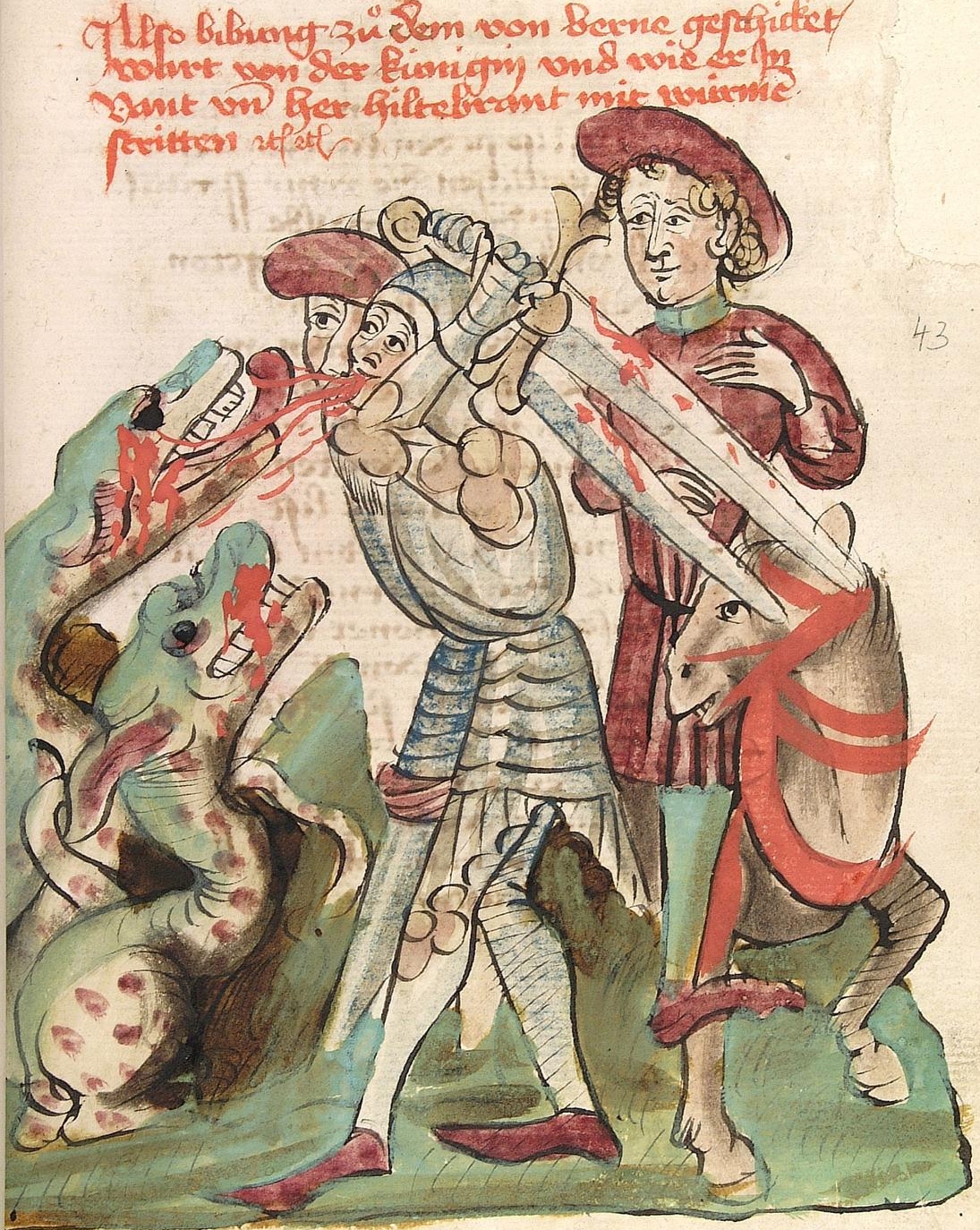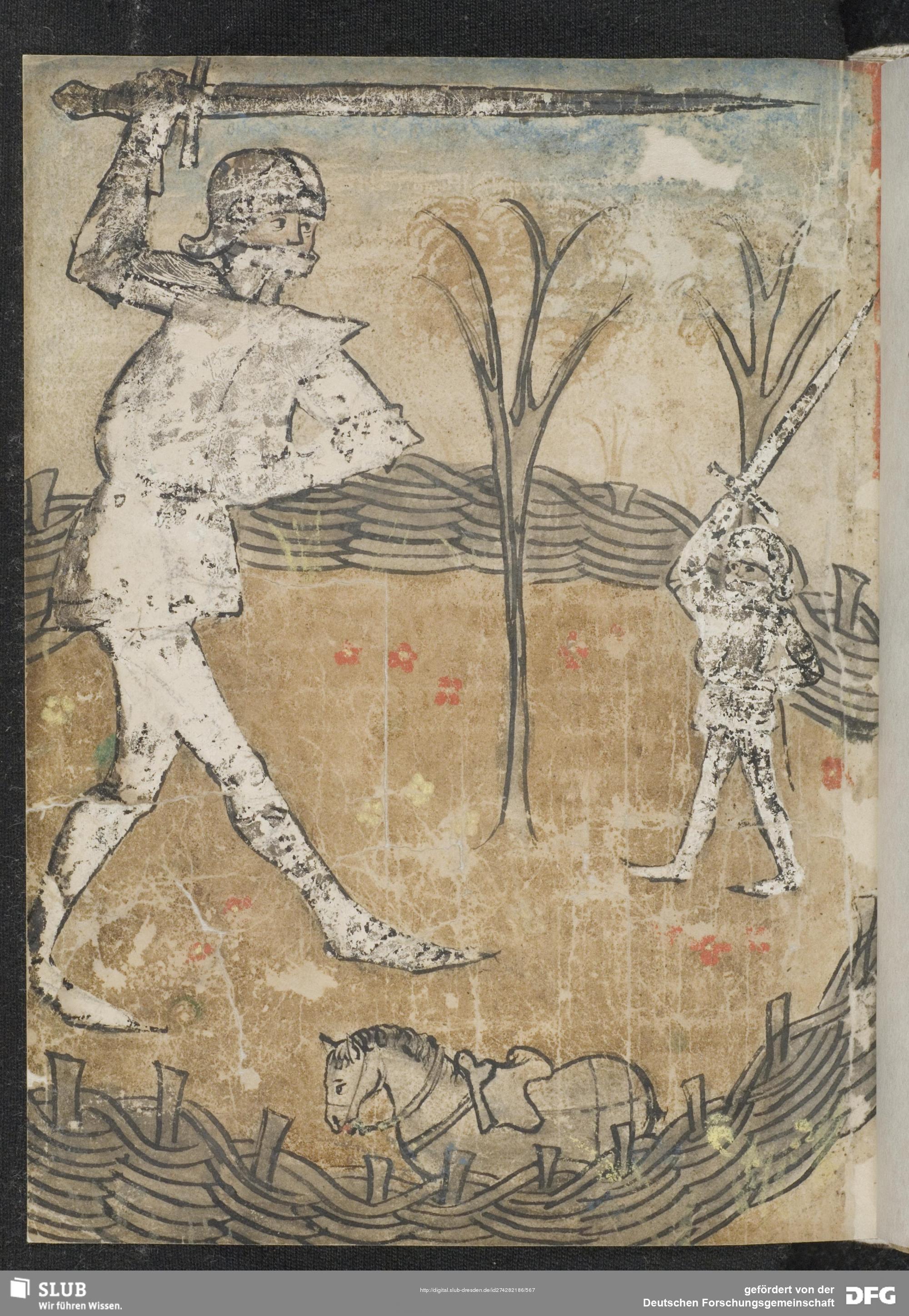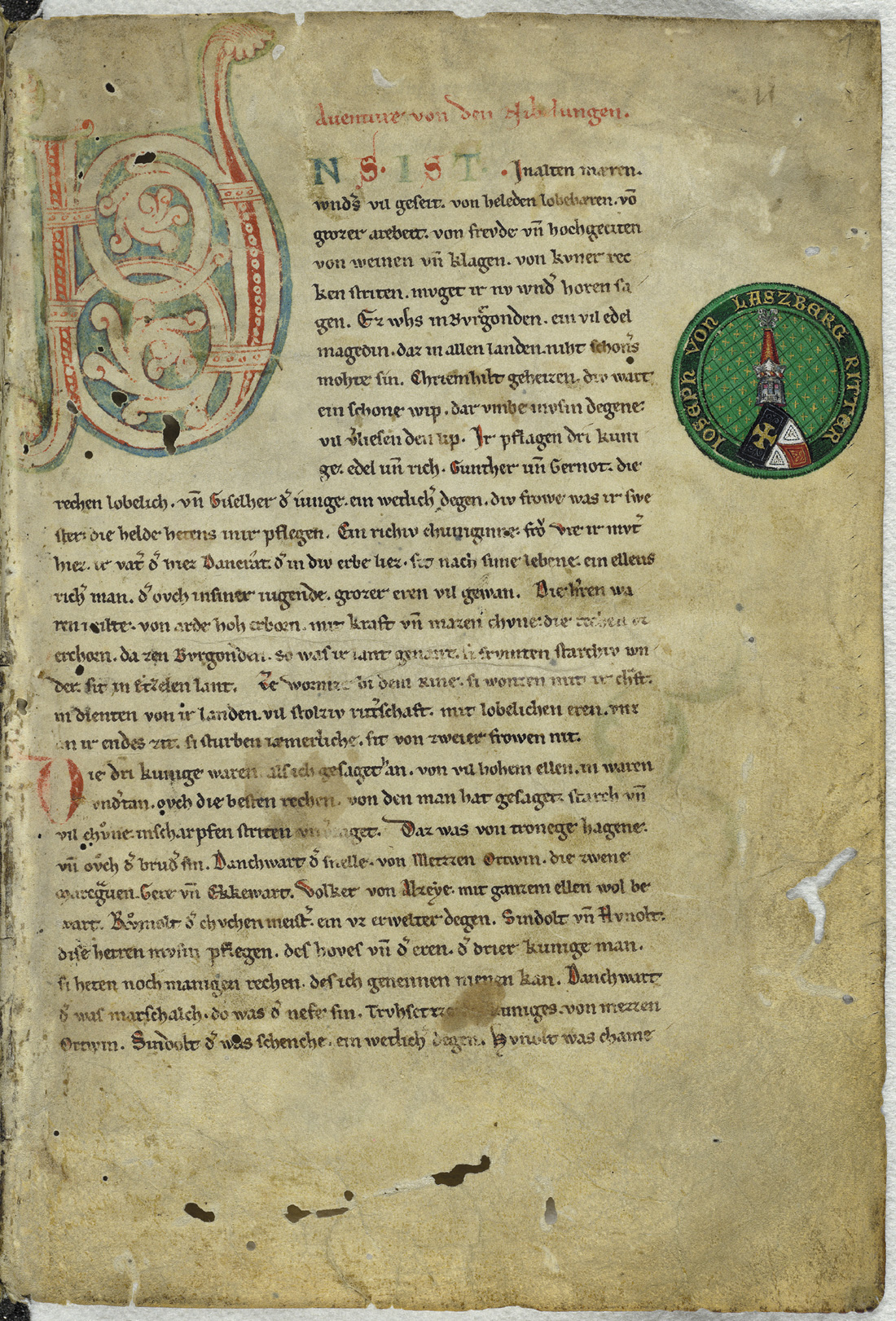|
Dietrich Of Bern
Dietrich von Bern is the name of a character in Germanic heroic legend who originated as a legendary version of the Ostrogothic king Theodoric the Great. The name "Dietrich", meaning "Ruler of the People", is a form of the Germanic name "Theodoric". In the legends, Dietrich is a king ruling from Verona (Bern) who was forced into exile with the Huns under Etzel by his evil uncle Ermenrich. The differences between the known life of Theodoric and the picture of Dietrich in the surviving legends are usually attributed to a long-standing oral tradition that continued into the sixteenth century. Most notably, Theodoric was an invader rather than the rightful king of Italy and was born shortly after the death of Attila and a hundred years after the death of the historical Gothic king Ermanaric. Differences between Dietrich and Theodoric were already noted in the Early Middle Ages and led to a long-standing criticism of the oral tradition as false. Legends about Theodoric may have ... [...More Info...] [...Related Items...] OR: [Wikipedia] [Google] [Baidu] |
Dietrich Und Hildebrand Kaempfen Gegen Drachen
Dietrich () is an ancient German name meaning "Ruler of the People.” Also "keeper of the keys" or a "lockpick" either the tool or the profession. Given name * Dietrich, Count of Oldenburg (c. 1398 – 1440) * Thierry of Alsace (german: Dietrich, link=no; 1099–1168), Count of Flanders * Dietrich of Ringelheim (9th century), Saxon count and father of St Matilda * Dietrich Bonhoeffer (1906–1945), German Lutheran pastor and theologian * Wilhelm Dietrich von Buddenbrock (1672–1757), Prussian field marshal and cavalry leader * Dieterich Buxtehude (c. 1637/39–1707), Danish-German composer and organist * Dietrich von Choltitz (1894–1966), German General and last commander of Nazi-occupied Paris in 1944 * Dietrich Eckart (1868–1923), German politician * Dietrich Enns (born 1991), American baseball player * Dietrich Fischer-Dieskau (1925–2012), German baritone singer * Dietrich von Hildebrand (1889–1977), German Catholic philosopher and theologian * Dietrich Hollinderbäum ... [...More Info...] [...Related Items...] OR: [Wikipedia] [Google] [Baidu] |
Middle High German
Middle High German (MHG; german: Mittelhochdeutsch (Mhd.)) is the term for the form of German spoken in the High Middle Ages. It is conventionally dated between 1050 and 1350, developing from Old High German and into Early New High German. High German is defined as those varieties of German which were affected by the Second Sound Shift; the Middle Low German and Middle Dutch languages spoken to the North and North West, which did not participate in this sound change, are not part of MHG. While there is no ''standard'' MHG, the prestige of the Hohenstaufen court gave rise in the late 12th century to a supra-regional literary language (') based on Swabian, an Alemannic dialect. This historical interpretation is complicated by the tendency of modern editions of MHG texts to use ''normalised'' spellings based on this variety (usually called "Classical MHG"), which make the written language appear more consistent than it actually is in the manuscripts. Scholars are uncertain as to ... [...More Info...] [...Related Items...] OR: [Wikipedia] [Google] [Baidu] |
Rosengarten Group
The Rosengarten group ( it, Catinaccio , Ladin: ''Ciadenac'', ''Ciadenáze'') is a massif in the Dolomites of northern Italy. It is located between the Tierser Tal and Eggental in South Tyrol and the Fassa Valley in Trentino. One peculiarity of the Rosengarten is the pink shade, owing to the presence of the mineral dolomite, which takes in the sunset and "glows", as celebrated in the ''Bozner Bergsteigerlied''. Meaning "Rose garden" in German, the name refers to the legend of King Laurin The South Tyrolean saga of King Laurin (German: ''König Laurin'', Ladin: ''Re Laurin'', Italian: ''Re Laurino'') is part of a popular tradition in the Dolomites. It is a popular explanation of the optical phenomenon of Alpenglow (Ladin: ''Enrosadi ... and his Rose Garden, a traditional story explaining the outer appearance of the mountain range. Summits The highest peak is the Kesselkogel at above sea level. Other peaks include: * Rosengartenspitze - * Vajolet-Türme - * Laurinswand (Cro ... [...More Info...] [...Related Items...] OR: [Wikipedia] [Google] [Baidu] |
Laurin (poem)
''Laurin'' or ''Der kleine Rosengarten'' (''The Small Rose Garden'') is an anonymous Middle High German poem about the legendary hero Dietrich von Bern, the counterpart of the historical Ostrogothic king Theodoric the Great in Germanic heroic legend. It is one of the so-called fantastical (''aventiurehaft'') Dietrich poems, so called because it more closely resembles a courtly romance than a heroic epic. It likely originates from the region of South Tyrol, possibly as early as 1230, though all manuscripts are later. The poem has five extant versions. In each, it concerns Dietrich's fight against the dwarf King Laurin, which takes place when Dietrich and Witege destroy Laurin's magical rose garden. The heroes are subsequently invited into Laurin's kingdom inside a mountain when it is discovered that Laurin has kidnapped and married the sister of Dietleib, one of Dietrich's heroes. Laurin betrays the heroes and imprisons them, but they are able to defeat him and save Dietleib's sis ... [...More Info...] [...Related Items...] OR: [Wikipedia] [Google] [Baidu] |
South Tyrol
it, Provincia Autonoma di Bolzano – Alto Adige lld, Provinzia Autonoma de Balsan/Bulsan – Südtirol , settlement_type = Autonomous province , image_skyline = , image_alt = , image_caption = , image_flag = Flag_of_South_Tyrol.svg , flag_alt = , image_shield = Suedtirol CoA.svg , shield_size = x100px , shield_alt = Coat of arms of Tyrol , anthem = , image_map = Bolzano in Italy.svg , map_alt = , map_caption = Map highlighting the location of the province of South Tyrol in Italy (in red) , coordinates = , coordinates_footnotes = , subdivision_type = Country , subdivision_name = Italy , subdivision_type1 = R ... [...More Info...] [...Related Items...] OR: [Wikipedia] [Google] [Baidu] |
Middle High German Literature
Middle High German literature refers to literature written in German between the middle of the 11th century and the middle of the 14th. In the second half of the 12th century, there was a sudden intensification of activity, leading to a 60-year "golden age" of medieval German literature referred to as the ''mittelhochdeutsche Blütezeit'' (). This was the period of the blossoming of ''Minnesang'', MHG lyric poetry, initially influenced by the French and Provençal tradition of courtly love song. The same sixty years saw the composition of the most important courtly romances. again drawing on French models such as Chrétien de Troyes, many of them relating Arthurian material. The third literary movement of these years was a new revamping of the heroic tradition, in which the ancient Germanic oral tradition can still be discerned, but tamed and Christianized and adapted for the court. Historical overview The vernacular literature of the Old High German period, written in abbeys an ... [...More Info...] [...Related Items...] OR: [Wikipedia] [Google] [Baidu] |
Nibelungenlied
The ( gmh, Der Nibelunge liet or ), translated as ''The Song of the Nibelungs'', is an epic poetry, epic poem written around 1200 in Middle High German. Its anonymous poet was likely from the region of Passau. The is based on an oral tradition of Germanic heroic legend that has some of its origin in historic events and individuals of the 5th and 6th centuries and that spread throughout almost all of Germanic languages, Germanic-speaking Europe. Scandinavian parallels to the German poem are found especially in the heroic lays of the ''Poetic Edda'' and in the ''Völsunga saga''. The poem is split into two parts. In the first part, the prince Sigurd, Siegfried comes to Worms, Germany, Worms to acquire the hand of the Burgundians, Burgundian princess Kriemhild from her brother King Gunther. Gunther agrees to let Siegfried marry Kriemhild if Siegfried helps Gunther acquire the warrior-queen Brünhild as his wife. Siegfried does this and marries Kriemhild; however, Brünhild and Krie ... [...More Info...] [...Related Items...] OR: [Wikipedia] [Google] [Baidu] |
Sigurd
Sigurd ( non, Sigurðr ) or Siegfried (Middle High German: ''Sîvrit'') is a legendary hero of Germanic heroic legend, who killed a dragon and was later murdered. It is possible he was inspired by one or more figures from the Frankish Merovingian dynasty, with Sigebert I being the most popular contender. Older scholarship sometimes connected him with Arminius, victor of the Battle of the Teutoburg Forest. He may also have a purely mythological origin. Sigurd's story is first attested on a series of carvings, including runestones from Sweden and stone crosses from the British Isles, dating from the eleventh century. In both the Norse and continental Germanic tradition, Sigurd is portrayed as dying as the result of a quarrel between his wife ( Gudrun/Kriemhild) and another woman, Brunhild, whom he has tricked into marrying the Burgundian king Gunnar/Gunther. His slaying of a dragon and possession of the hoard of the Nibelungen is also common to both traditions. In other respect ... [...More Info...] [...Related Items...] OR: [Wikipedia] [Google] [Baidu] |
Hero
A hero (feminine: heroine) is a real person or a main fictional character who, in the face of danger, combats adversity through feats of ingenuity, courage, or Physical strength, strength. Like other formerly gender-specific terms (like ''actor''), ''hero'' is often used to refer to any gender, though ''heroine'' only refers to women. The original hero type of classical epics did such things for the sake of glory (honor), glory and honor. post-classical history, Post-classical and modern history, modern heroes, on the other hand, perform great deeds or selfless acts for the common good instead of the classical goal of wealth, pride, and fame. The antonym of ''hero'' is ''villain''. Other terms associated with the concept of ''hero'' may include ''good guy'' or ''wikt:white hat, white hat''. In Classics, classical literature, the hero is the main or revered character in Epic poetry, heroic epic poetry celebrated through ancient legends of a people, often striving for milit ... [...More Info...] [...Related Items...] OR: [Wikipedia] [Google] [Baidu] |
Giant
In folklore, giants (from Ancient Greek: '' gigas'', cognate giga-) are beings of human-like appearance, but are at times prodigious in size and strength or bear an otherwise notable appearance. The word ''giant'' is first attested in 1297 from Robert of Gloucester's chronicle. It is derived from the ''Gigantes'' ( grc-gre, Γίγαντες) of Greek mythology. Fairy tales such as '' Jack the Giant Killer'' have formed the modern perception of giants as dimwitted ogres, sometimes said to eat humans, while other giants tend to eat the livestock. The antagonist in ''Jack and the Beanstalk'' is often described as a giant. In some more recent portrayals, like those of Jonathan Swift and Roald Dahl, some giants are both intelligent and friendly. Literary and cultural analysis Giants appear in the folklore of cultures worldwide as they represent a relatively simple concept. Representing the human body enlarged to the point of being monstrous, giants evoke terror and remind humans ... [...More Info...] [...Related Items...] OR: [Wikipedia] [Google] [Baidu] |
Dragon
A dragon is a reptilian legendary creature that appears in the folklore of many cultures worldwide. Beliefs about dragons vary considerably through regions, but dragons in western cultures since the High Middle Ages have often been depicted as winged, horned, and capable of breathing fire. Dragons in eastern cultures are usually depicted as wingless, four-legged, serpentine creatures with above-average intelligence. Commonalities between dragons' traits are often a hybridization of feline, reptilian and avian features. Scholars believe huge extinct or migrating crocodiles bear the closest resemblance, especially when encountered in forested or swampy areas, and are most likely the template of modern Oriental dragon imagery. Etymology The word ''dragon'' entered the English language in the early 13th century from Old French ''dragon'', which in turn comes from la, draconem (nominative ) meaning "huge serpent, dragon", from Ancient Greek , (genitive , ) "serpent, giant s ... [...More Info...] [...Related Items...] OR: [Wikipedia] [Google] [Baidu] |
Dwarf (mythology)
A dwarf () is a type of supernatural being in Germanic folklore, including mythology. Accounts of dwarfs vary significantly throughout history however they are commonly, but not exclusively, presented as living in mountains or stones and being skilled craftsmen. In early literary sources, only males are explicitly referred to as dwarfs, although they are described as having sisters and daughters, while both male and female dwarfs feature in later saga literature and folklore. Dwarfs are sometimes described as short, however, scholars have noted that this is neither explicit nor of relevance to their roles in the earliest sources. Dwarfs continue to feature in modern popular culture such as in the works of J.R.R. Tolkien and Terry Pratchett, where they are often, but not exclusively, presented as distinct from elves. Etymology The modern English noun ''dwarf'' descends from ang, dweorg. It has a variety of cognates in other Germanic languages, including non, dvergr and goh, tw ... [...More Info...] [...Related Items...] OR: [Wikipedia] [Google] [Baidu] |










-ed-Nibelungen_Not-p091-sigfird&alberich-gezwerge.jpg)